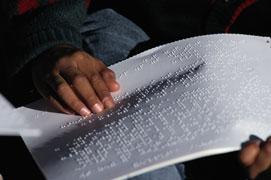What it is
A medical condition of the eyes that involves a severe impairment in vision, not corrected by glasses.
Teaching Strategies

Instructional
• Provide copies of written texts and handouts in large print or Braille.
• Use appropriate assistive technology.
• Implement strategies received from a teacher of the blind.
• Use other media sources for delivering information (audio cassette, voice file).
• Use physical models and/or concrete materials whenever possible, to help the student understand concepts.
• Describe items and instructions in detail.
• Frequently ask the student questions to ensure proper understanding.
• Teach new vocabulary in advance of the lesson.
• Read out loud what is written on the board.
• Use an auditory signal for class attention and to signal a change of activities.
• Encourage self-advocacy; consider the development of an alternative programming goal.
Less...
More...

Environmental
• Consistently keep items in predictable/predetermined places (desks, chairs, scissors, etc.).
• Give the student appropriate warning of any changes to the classroom set up, and provide support for familiarizing with the new set up.
• Use preferential seating so that the student is close to the teacher for additional instructions.
• Reduce auditory noise in classroom.
• Provide easy access to Braille equipment, if appropriate.
• Provide elevator access if necessary/available.
• Develop and practice a plan for emergency evacuations to ensure safety.

Assessment
• Use assistive technology and Braille materials.
• Provide extra time.
• Use oral tests/scribe.
• Provide choices for projects/assignments.
See the Blind and Low Vision Exceptionality page for more informations and resources.
Resources
|
|
|
|
Braille Information |
Numerous links, organized by specific topic. |
|
W. Ross Macdonald School (Brantford ON). |







